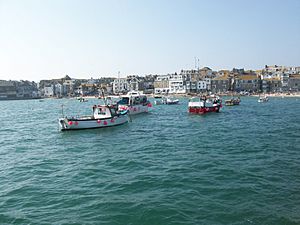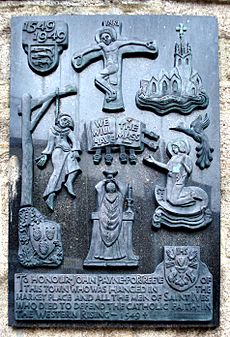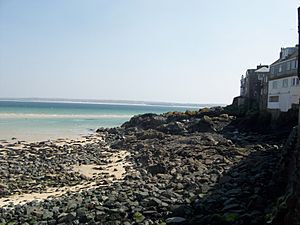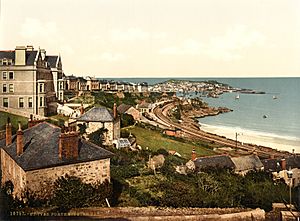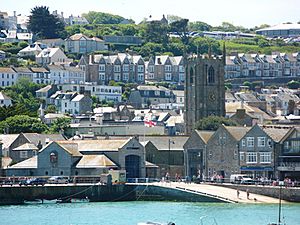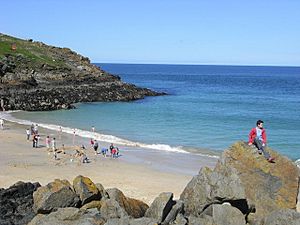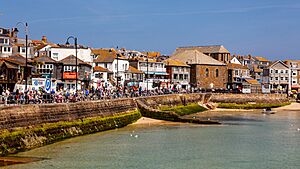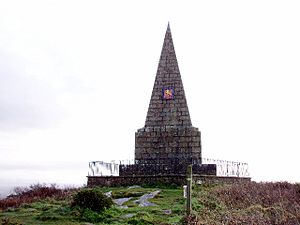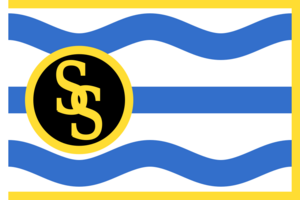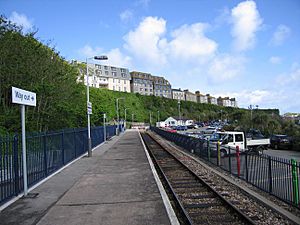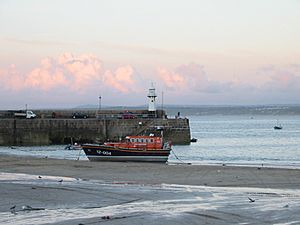St Ives, Cornwall facts for kids
Quick facts for kids St Ives
|
|
|---|---|
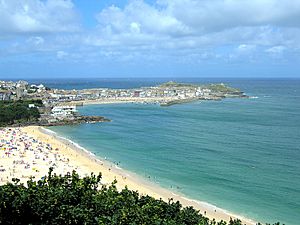 St Ives Harbour and Porthminster Beach |
|
| Lua error in Module:Location_map at line 530: Unable to find the specified location map definition: "Module:Location map/data/Cornwall (mainland)" does not exist. | |
| Population | 10,756 United Kingdom Census 2021 |
| OS grid reference | SW518403 |
| Civil parish |
|
| Unitary authority | |
| Ceremonial county | |
| Region | |
| Country | England |
| Sovereign state | United Kingdom |
| Post town | ST. IVES |
| Postcode district | TR26 |
| Dialling code | 01736 |
| Police | Devon and Cornwall |
| Fire | Cornwall |
| Ambulance | South Western |
| EU Parliament | South West England |
| UK Parliament |
|
St Ives (Cornish: Porth Ia, meaning "St Ia's cove") is a lovely seaside town and port in Cornwall, England. It's located on the coast of the Celtic Sea, north of Penzance.
Long ago, St Ives was mostly known for its fishing. But when fishing became less common, the town changed. Now, it's a very popular seaside resort! St Ives even won the award for "Best UK Seaside Town" in 2010 and 2011. The town has also become famous for its many artists.
Contents
History of St Ives
How St Ives Began
The story of St Ives starts with an Irish saint named Ia of Cornwall. She is said to have arrived here in the 5th century. The town's church is named after her, and that's where St Ives gets its name!
The Sloop Inn is a very old pub on the wharf. It was a popular spot for fishermen for hundreds of years. It's thought to be from around 1312, making it one of the oldest inns in Cornwall.
During the Prayer Book Rebellion in 1549, a sad event happened in St Ives. The English leader, Anthony Kingston, had the town's portreeve (a local official), John Payne, arrested. John Payne was then executed for being a "busy rebel."
In 1597, during the Spanish Armada, two Spanish ships came to St Ives. They were trying to find shelter from a big storm. But they were captured by an English warship. The information from the captured sailors was very important for the English.
Fishing in St Ives
Fishing has been important in St Ives since medieval times. It was once the most important fishing port on Cornwall's north coast. The pier was built by John Smeaton between 1767 and 1770. It has been made longer since then.
Fishermen in St Ives used to catch huge amounts of fish, especially pilchards. For example, in 1868, a massive 5,600 hogsheads of fish were caught in one go! A "hogshead" was a very large barrel. Most of these fish were sent to Italy.
St Ives fishermen were very strict about resting on Sundays. They used a fishing method called "seining," which involved three boats and many crew members. This type of fishing stopped in 1924.
Today, there isn't as much commercial fishing. But the harbour is still busy with recreational boats. You can also go on tourist fishing trips or day trips to see the nearby seal colonies. There are even special boats called "jumbos," which are copies of old Victorian fishing boats unique to St Ives.
St Ives Lifeboat Station
The first lifeboat in St Ives arrived in 1840. The Royal National Lifeboat Institution (RNLI) built a boathouse in 1867. Over the years, new and larger boathouses were built. The current one was built in 1993.
A very sad event happened in 1939. Seven brave crewmen died in the St Ives lifeboat tragedy. On January 23, 1939, a huge storm was blowing. The lifeboat John and Sara Eliza Stych went out to help a ship in trouble. The storm was so strong that the lifeboat capsized three times. Six men were lost, and only one man survived. He managed to get to shore when the boat was wrecked on rocks.
St Ives in Modern Times
St Ives became a popular seaside resort when the St Ives Bay branch railway line opened in 1877. This made it easy for Victorian holidaymakers to visit. Many parts of the town were built in the late 1800s. The railway line is still a popular attraction today. It winds along the cliffs and bays, offering beautiful views.
In 1999, St Ives was the first place in the UK to see the Solar eclipse of August 11, 1999. Sadly, clouds covered the sky, so people couldn't see it clearly.
Sharks in St Ives Bay
Sometimes, there are reports of sharks in St Ives Bay. In 2007, people thought they saw a great white shark. Experts said it was hard to be sure, and it might have been a different type of shark. In 2011, there was another report of a rare oceanic whitetip shark. Experts said it was very unlikely for that type of shark to be in British waters.
Geography of St Ives
St Ives is on the western side of St Ives Bay. Its harbour is protected by St Ives Island (which is actually a headland) and Smeaton's pier. The streets near the harbour are narrow and winding. The newer parts of town have wider streets on higher ground.
St Ives has four main beaches:
- Porthmeor is great for surfing.
- Porthgwidden is a small, sandy cove.
- Harbour Beach is right by the working port.
- Porthminster has almost half a mile of beautiful sand.
St Ives has a mild climate, meaning it has some of the mildest winters and warmest summers in Britain. This makes it a very popular place for tourists, especially in summer. The South West Coast Path also goes through the town, offering amazing walks.
Tourism in St Ives
St Ives has been a popular tourist destination since the railway opened in 1877. It has been named the best UK seaside town multiple times. St Ives is a very popular place to visit, with hundreds of thousands of day-trippers and staying tourists each year. Tourism provides many jobs in the area.
However, tourism also brings some challenges. It can make it hard for local people to find affordable homes. In 2016, people in St Ives voted to stop second-home owners from buying new houses. This was because house prices were very high, making it difficult for local families to afford to live there.
Religion in St Ives
The main church in St Ives is dedicated to Saint Ia of Cornwall and St Andrew, who is the patron saint of fishermen. The church was built between 1410 and 1434.
There are also other churches in St Ives. The Roman Catholic Church of the Sacred Heart and St Ia was built in 1909. You can also find two Methodist chapels and a Congregational chapel in the town. There are small chapels dedicated to St Nicholas and St Leonard on the headland and quay. These were once used by fishermen.
Culture and Art in St Ives
St Ives: A Hub for Artists
St Ives has a long history of attracting artists. Famous painters like J. M. W. Turner visited in 1811. Later, in 1884, James Whistler and Walter Sickert came by train.
In 1920, Bernard Leach and Shōji Hamada started the Leach Pottery. Bernard Leach is known as the "Father of British studio pottery." He learned pottery in Japan and brought new ideas to the art. The Leach Pottery is still open today and has a museum.
In 1928, artists like Alfred Wallis, Ben Nicholson, and Christopher Wood met in St Ives. They helped create the famous St Ives School artists' colony. Later, in 1939, Ben Nicholson, Barbara Hepworth, and Naum Gabo moved to St Ives because of its beauty.
In 1993, a branch of the Tate Gallery, called the Tate St Ives, opened. The Tate also looks after the Barbara Hepworth Museum and her sculpture garden. St Ives continues to attract artists from all over the world.
In the 1940s, artists in St Ives had different ideas about art. Some liked abstract art (shapes and colours), while others preferred figurative art (showing real things). In 1948, the abstract artists formed a new group called the Penwith Society of Artists.
A BBC film called The Art of Cornwall said that St Ives artists "produced some of the most exciting art of the twentieth century." For a time, St Ives was as famous for art as Paris or New York!
Museums to Explore
The Barbara Hepworth Museum and Sculpture Garden is managed by Tate St Ives. Barbara Hepworth wanted her amazing sculptures to be on public display forever.
The St Ives Museum shows the town's local history and culture. You can learn about mining, fishing, farming, and how people used to live.
Fun Festivals in St Ives
John Knill, a former mayor, built a granite monument called Knill's Steeple. Every five years on July 25, a special ceremony called the Knill Ceremony takes place. The Mayor of St Ives, a customs officer, and a vicar join two widows and ten girls for this unique event.
Another old celebration is St Ives Feast. It celebrates the founding of St Ives by St Ia. It happens around February 3 each year and includes a procession to St Ia's well. It's one of the few places where you can still see Cornish Hurling, a traditional game.
St Ives also has a May Day celebration, which is a modern version of old West Cornwall May Day celebrations.
The St Ives September Festival is a big arts festival that lasts for fifteen days. It includes music, poetry, films, talks, and books. Many local artists open their studios so visitors can see how they create their art. There's also free music in pubs and concerts.
St Ives on Film and TV
St Ives has been featured in movies and TV shows.
- In 1980, parts of the film Raise the Titanic were filmed in the town.
- In 1989, a TV show about American artist Sydney Mortimer Laurence filmed scenes here. Local people even dressed up in old costumes to be extras!
- The TV show Beach Café, featuring Australian chef Michael Smith, was also filmed in St Ives.
Local News and Radio
For local news, you can watch BBC South West and ITV West Country. You can also listen to local radio stations like BBC Radio Cornwall and Coast FM. The local newspaper is the St. Ives Times & Echo.
Sports in St Ives
St Ives is home to the St Ives Rugby Football Club, which started in 1889. They play at the Recreation Ground. There's also a football team, St Ives Town F.C.
Cornish Wrestling
Cornish wrestling tournaments used to be held in St Ives at places like the Knill mausoleum and Tregenna Park.
Getting Around St Ives
The St Ives railway station connects to the main train line that runs from London to Penzance. The St Ives branch line offers frequent services from St Erth. This line opened in 1877. Many visitors use a "park and ride" facility at St Erth to take the train into St Ives. The branch line also links St Ives to nearby Carbis Bay and Lelant.
You can also get to St Ives by bus. National Express coaches come from London and other parts of Britain. First Kernow buses connect St Ives to nearby towns like Penzance and Truro.
The closest airports are Newquay and Land's End Airport.
Twin Towns
St Ives is twinned with Camaret-sur-Mer in France. This means they are "sister cities" and have a special friendship. St Ives also has friendship agreements with Laguna Beach, California in the USA and Mashiko, Tochigi in Japan. In 2014, St Ives and Laguna Beach officially became sister cities.
Famous People from St Ives
Many interesting people have lived in or been connected to St Ives:
Before 1900
- Jonathan Toup (1713–1785) was a smart scholar who studied old languages.
- John Knill (1733–1811) was a unique mayor of St Ives. He created the special Knill Ceremony.
- Edward Hain (1851–1917) was a shipping owner and a Member of Parliament for St Ives.
- Percy Lane Oliver (1878–1944) started the first volunteer blood donor service in 1921.
- Virginia Woolf (1882–1941) was a famous English novelist. She spent much of her childhood in St Ives.
Since 1900
- Mabel Lethbridge (1900–1968) was very brave. She was the youngest person to receive a British Empire Medal after being injured in a factory during World War I.
- Barbara Hepworth (1903–1975) was a very important English artist and sculptor. She lived and worked in St Ives from 1949.
- George Lloyd (1913–1998) was a British composer.
- Peter Lanyon (1918–1964) was a Cornish painter known for his abstract landscapes.
- Patrick Heron (1920–1999) was a British abstract and figurative artist.
- Bryan Pearce (1929–2007) was a British painter known for his simple, "naïve" art style.
- John Nott (born 1932) was a British politician who served as Secretary of State for Defence during the Falklands War.
- Fleur Bennett (born 1968) is a British TV actress.
- Fink (born 1972), whose real name is Fin Greenall, is an English singer and songwriter.
See also
 In Spanish: St Ives (Cornualles) para niños
In Spanish: St Ives (Cornualles) para niños


